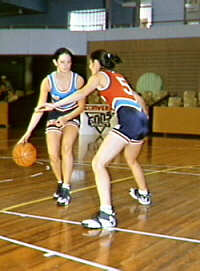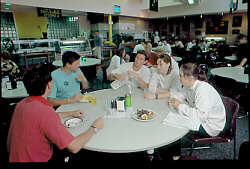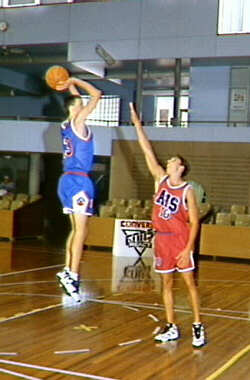 | ||
 |
||
|
| ||
Basketball Characteristics of the Sport A basketball game can be played in four 12-minute quarters, or in two 20-minute halves, with a break of 10-15 minutes at half-time. Since the timing clock stops when the ball is out of play, the actual time elapsed for each game is considerably more. At the elite level, basketball is fast-paced, skilled and physical. Considerable demands are placed upon anaerobic energy systems, with aerobic fitness assisting recovery between bursts of play. Training Most players at the elite level are active all year, undertaking personal training when the team does not hold official practice. At lower levels, players may have longer breaks between sessions, and find themselves at risk for weight gain and loss of fitness during this time. Training loads vary according to time of the season and the number of games played each week. During the competitive season, the team will normally have 3-4 team sessions per week, plus individual sessions. At the non-elite level, training loads vary. Competition Elite teams play a combination of home games, involving a single game per weekend, and tours, involving 2 or 3 games over a Friday night, Saturday and Sunday. At a sub-elite level, many players enjoy playing for a number of teams, or in a number of competitions, and may have a weekly commitment of 2-3 matches. In addition, regular tournaments may be scheduled requiring several games in a weekend. The need to recover quickly between matches, and to make good food choices while on the road or at tournaments, are common challenges for basketballers. Physical Characteristics Height is the most noticeable physical characteristic of basketball players. Low-medium body-fat levels are an advantage in improving agility and speed, but basketball players need to develop strength and good body positioning to withstand the contact in a game. Common Nutrition Issues Case history – getting organised Young basketball players tend to be tall with large energy needs for growth. A single game of basketball does not provide a great threat to the fuel capabilites of trained athletes. However, in many situations players struggle with their recovery, due to a combination of regular training and matches, and an unorganised meal plan. Games tend to be at night, which impinges on meal times. Many young players are offered contracts to teams in the major basketball competitions, which require them to move out of home before they have learned all the tricks to domestic life. The following ideas can help to get organised to eat well.
Iron status Iron is an important nutrient for growth. Impact against other players or the floor may increase iron losses through increased red blood cell destruction. Some players may have problems with low iron status especially females with low iron intakes. Iron levels should be checked regularly when in heavy training. Iron-rich foods such as lean red meat and breakfast cereals fortified with iron (eg Kellogg's Sustain) should be included regularly in the diet. Iron-rich plant foods such as wholegrain cereals, spinach and legumes should be combined with animal iron sources (eg wholemeal pasta and bolognaise sauce) or vitamin C sources (a glass of juice consumed with breakfast cereal) to improve iron absorption. A sports dietitian will be able to provide specific dietary help. Game Preparation – the pre-event meal The pre-game meal should fuel and hydrate players, but leave them feeling comfortable for the game. Ideally, the menu calls for a high-carbohydrate choice eaten at least 2-3 hours before a game. Pasta with low-fat sauces, rolls or sandwiches, baked potatoes with low-fat fillings, creamed rice, and fruit salad with yoghurt, are all examples of suitable choices. Each player or team should experiment to find the routines that work best for their situation. Eating together as a team can be a great way to raise team morale and get focused for the game. It also ensures that all players have their pre-game nutrition needs looked after. Fluids during training and games High-intensity exercise in a controlled atmosphere stadium can lead to large sweat losses – especially in large players. The good news is that basketball offers plenty of opportunities to hydrate during the game – time outs, quarter- or half-time breaks, and time spent on the bench. Hopefully, the coach will organise frequent drink breaks during practice. Each player should have their own drink bottle courtside, so that they can keep track of how much they are drinking. In professional teams, the job of refilling bottles is often left to the team manager or other support staff member. Water is a suitable fluid, but a sports drink may promote better performance by topping up fuel stores for both the muscle and brain. Remember that basketball is not only a game of high-intensity running, but of skill, concentration and decision-making. These last factors are impaired both by dehydration and lowering of blood glucose levels. Sports drinks top up carbohydrate needs during the game, but may also encourage you to drink more fluid. In a recent study of fluid intake practices during training by AIS basketball teams, we found that men and women both drank more fluid when a sports drink was offered, than when the fluid on offer was plain water. This occurred even though the players reported liking water better! It is an interesting exercise to monitor weight changes of players and their drink bottles during practice and games, and estimate their sweat losses and fluid intakes. The following results were found in studies of the AIS men's and women's basketball teams. Note that fluid losses are still high during winter sessions when it is chilly outside and many players don't think they need to bring a drink. Remember that the stadium is kept warmer than the outside conditions, and the players are working hard and producing their own heat. We found considerable variation between sweat rates and drinking patterns of different players – many drank well, but others needed encouragement.
Post-game recovery tactic Effective recovery begins with the intake of fluid, carbohydrate and other important nutrients. Left to chance, recovery eating may take a back seat to the post-game meetings, stretching and injury treatment, drug testing, media interviews, or the trip back to home or the team hotel. Many teams organise post-game recovery snacks that can be consumed simultaneously with these activities – sports drinks, liquid meal supplements, fruit, sandwiches and cereal bars are some of the many quick options. Depending on the time of the game and the athlete's appetite, this post-game snack may be supplemented by a later meal. Tournament nutrition and road trips As soon as the match schedule is known, plan a meal routine that schedules appropriate pre-event meals and recovery strategies. When several games are played in succession over as many days, proactive recovery techniques will be important in maintaining performance right through the end of the schedule. If you are playing away from home, plan where you will be eating meals, and organise the menus in advance. It is stress-free when a hungry team arrives at a restaurant to find buffet-style meals waiting, tailor-made to their special needs. Similarly, take control of meals eaten on planes, buses and other travel options. Always carry some high-carbohydrate snacks such as cereal bars, fruit and yoghurt for emergencies. In hotels, empty the mini-bars to make room for more nutritious snacks and drinks.
You will find more information about basketball at the
Australian Institute of Sport on the
|
| |||||||||||||||||||||||||||||||||||
|
The Department of Sports Nutrition is a program of the
Australian Institute of Sport General enquires can be emailed to: aisnutrition@ausport.gov.au Copyright
© Australian Sports Commission
| ||||||||||||||||||||||||||||||||||||





